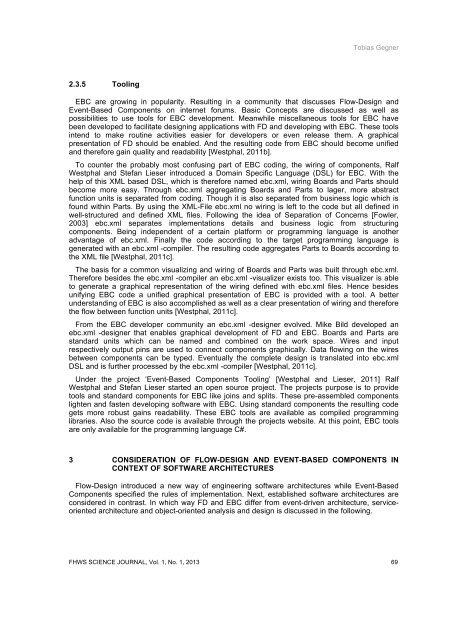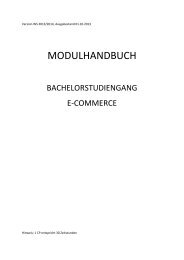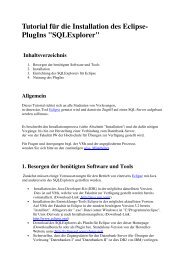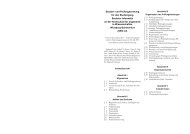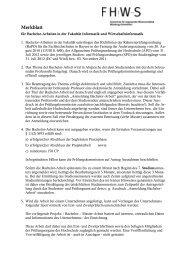FHWS Science Journal - Fakultät Informatik und Wirtschaftsinformatik
FHWS Science Journal - Fakultät Informatik und Wirtschaftsinformatik
FHWS Science Journal - Fakultät Informatik und Wirtschaftsinformatik
You also want an ePaper? Increase the reach of your titles
YUMPU automatically turns print PDFs into web optimized ePapers that Google loves.
Tobias Gegner<br />
2.3.5 Tooling<br />
EBC are growing in popularity. Resulting in a community that discusses Flow-Design and<br />
Event-Based Components on internet forums. Basic Concepts are discussed as well as<br />
possibilities to use tools for EBC development. Meanwhile miscellaneous tools for EBC have<br />
been developed to facilitate designing applications with FD and developing with EBC. These tools<br />
intend to make routine activities easier for developers or even release them. A graphical<br />
presentation of FD should be enabled. And the resulting code from EBC should become unified<br />
and therefore gain quality and readability [Westphal, 2011b].<br />
To counter the probably most confusing part of EBC coding, the wiring of components, Ralf<br />
Westphal and Stefan Lieser introduced a Domain Specific Language (DSL) for EBC. With the<br />
help of this XML based DSL, which is therefore named ebc.xml, wiring Boards and Parts should<br />
become more easy. Through ebc.xml aggregating Boards and Parts to lager, more abstract<br />
function units is separated from coding. Though it is also separated from business logic which is<br />
fo<strong>und</strong> within Parts. By using the XML-File ebc.xml no wiring is left to the code but all defined in<br />
well-structured and defined XML files. Following the idea of Separation of Concerns [Fowler,<br />
2003] ebc.xml separates implementations details and business logic from structuring<br />
components. Being independent of a certain platform or programming language is another<br />
advantage of ebc.xml. Finally the code according to the target programming language is<br />
generated with an ebc.xml -compiler. The resulting code aggregates Parts to Boards according to<br />
the XML file [Westphal, 2011c].<br />
The basis for a common visualizing and wiring of Boards and Parts was built through ebc.xml.<br />
Therefore besides the ebc.xml -compiler an ebc.xml -visualizer exists too. This visualizer is able<br />
to generate a graphical representation of the wiring defined with ebc.xml files. Hence besides<br />
unifying EBC code a unified graphical presentation of EBC is provided with a tool. A better<br />
<strong>und</strong>erstanding of EBC is also accomplished as well as a clear presentation of wiring and therefore<br />
the flow between function units [Westphal, 2011c].<br />
From the EBC developer community an ebc.xml -designer evolved. Mike Bild developed an<br />
ebc.xml -designer that enables graphical development of FD and EBC. Boards and Parts are<br />
standard units which can be named and combined on the work space. Wires and input<br />
respectively output pins are used to connect components graphically. Data flowing on the wires<br />
between components can be typed. Eventually the complete design is translated into ebc.xml<br />
DSL and is further processed by the ebc.xml -compiler [Westphal, 2011c].<br />
Under the project ‘Event-Based Components Tooling’ [Westphal and Lieser, 2011] Ralf<br />
Westphal and Stefan Lieser started an open source project. The projects purpose is to provide<br />
tools and standard components for EBC like joins and splits. These pre-assembled components<br />
lighten and fasten developing software with EBC. Using standard components the resulting code<br />
gets more robust gains readability. These EBC tools are available as compiled programming<br />
libraries. Also the source code is available through the projects website. At this point, EBC tools<br />
are only available for the programming language C#.<br />
3 CONSIDERATION OF FLOW-DESIGN AND EVENT-BASED COMPONENTS IN<br />
CONTEXT OF SOFTWARE ARCHITECTURES<br />
Flow-Design introduced a new way of engineering software architectures while Event-Based<br />
Components specified the rules of implementation. Next, established software architectures are<br />
considered in contrast. In which way FD and EBC differ from event-driven architecture, serviceoriented<br />
architecture and object-oriented analysis and design is discussed in the following.<br />
<strong>FHWS</strong> SCIENCE JOURNAL, Vol. 1, No. 1, 2013 69


